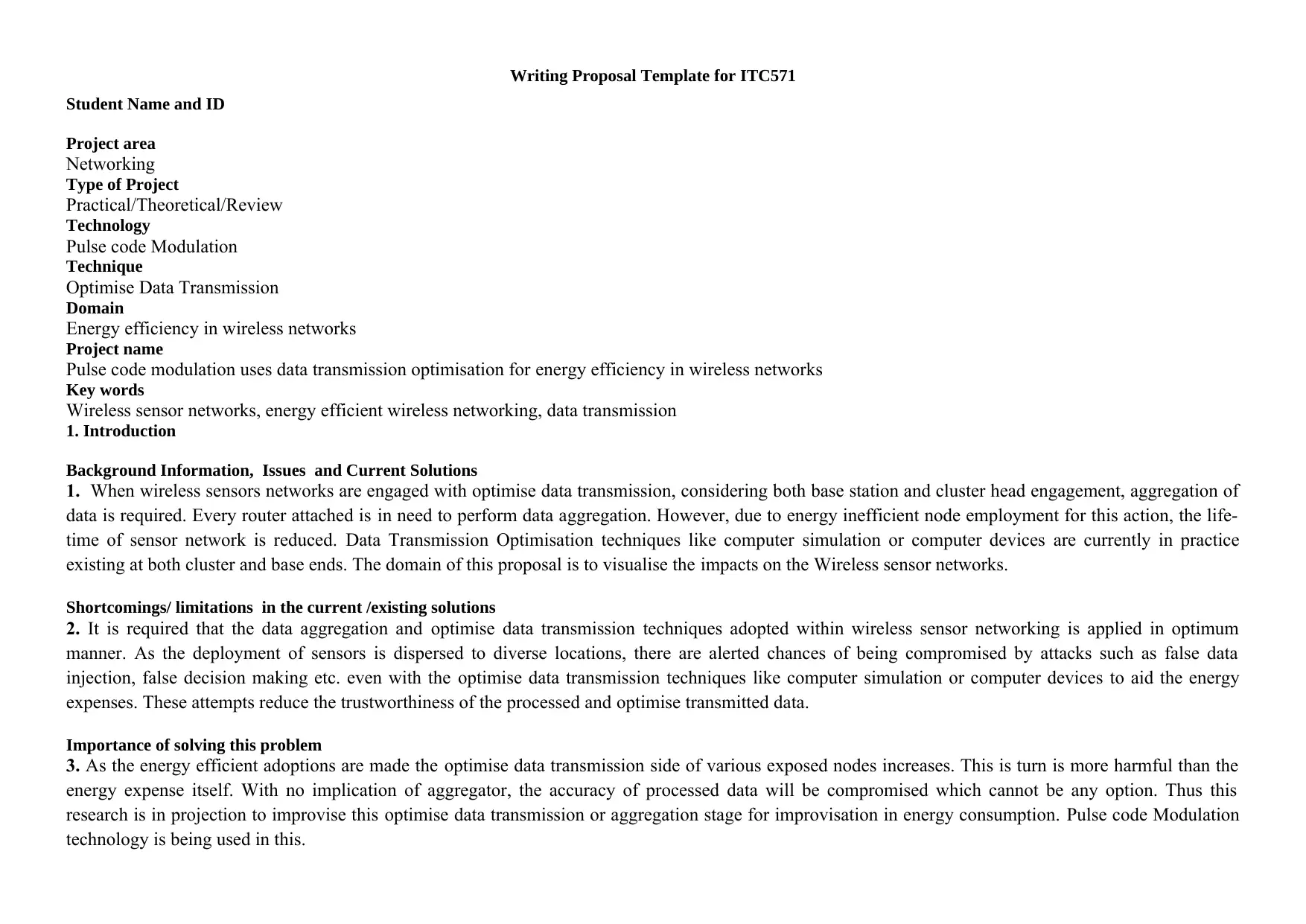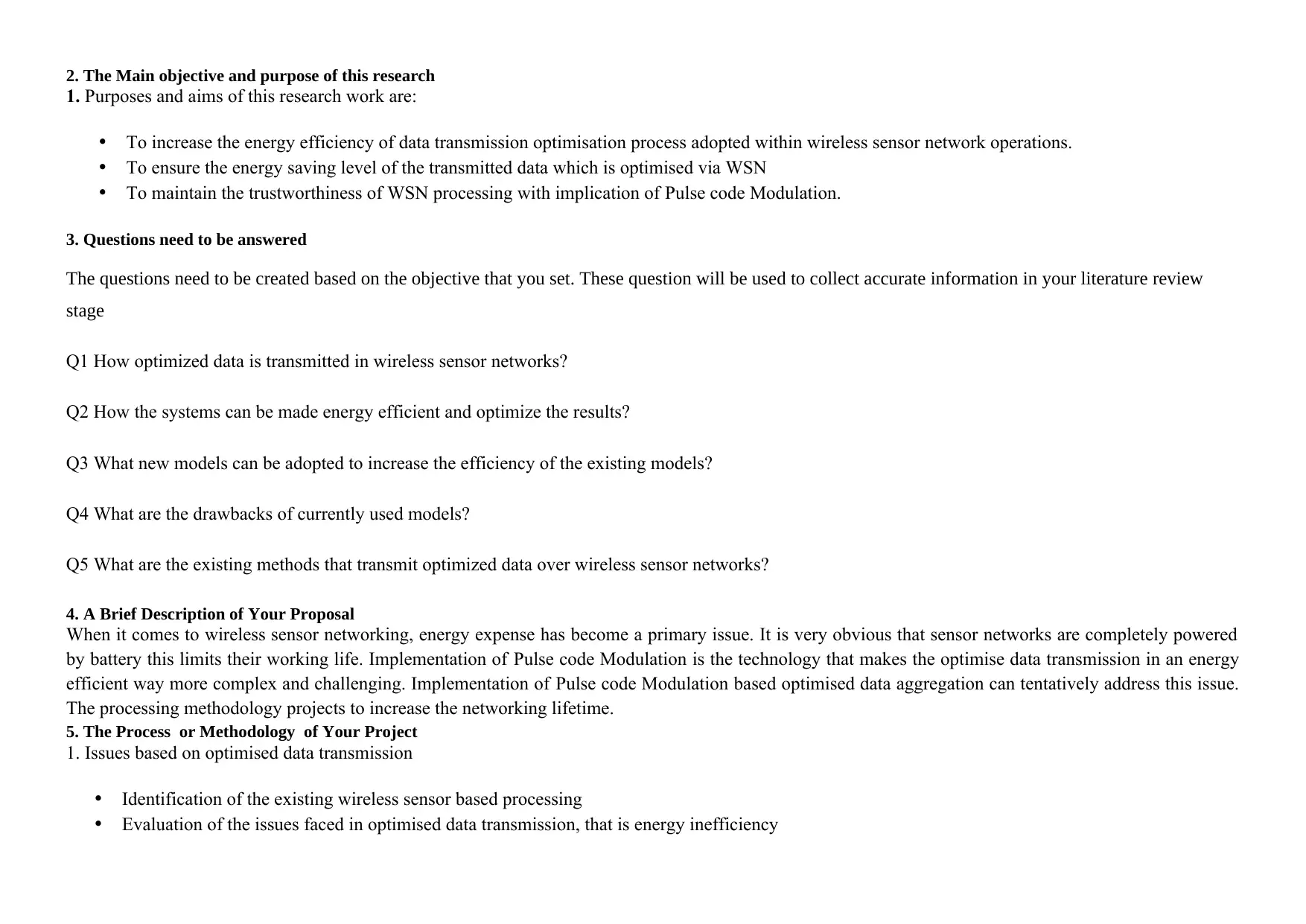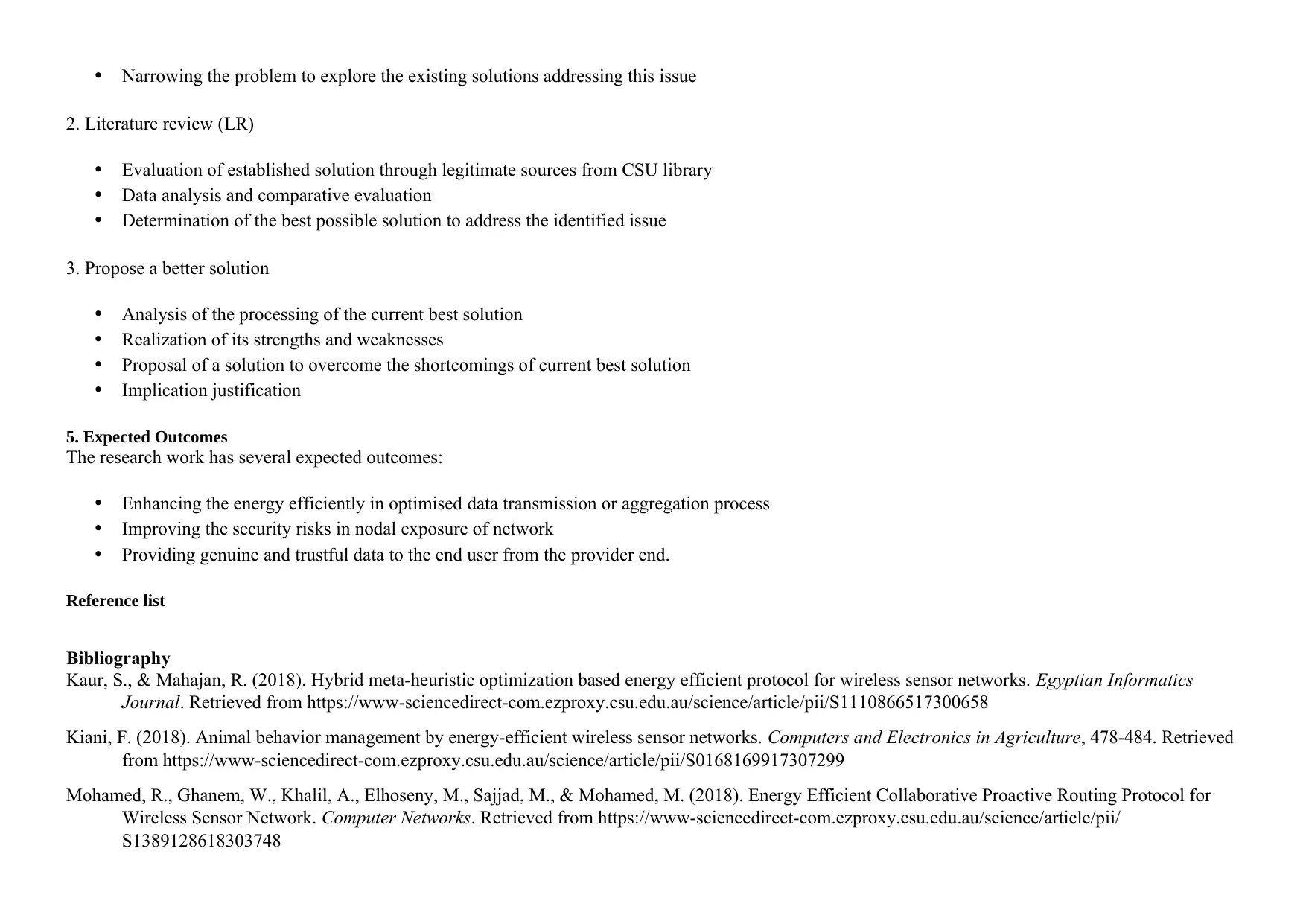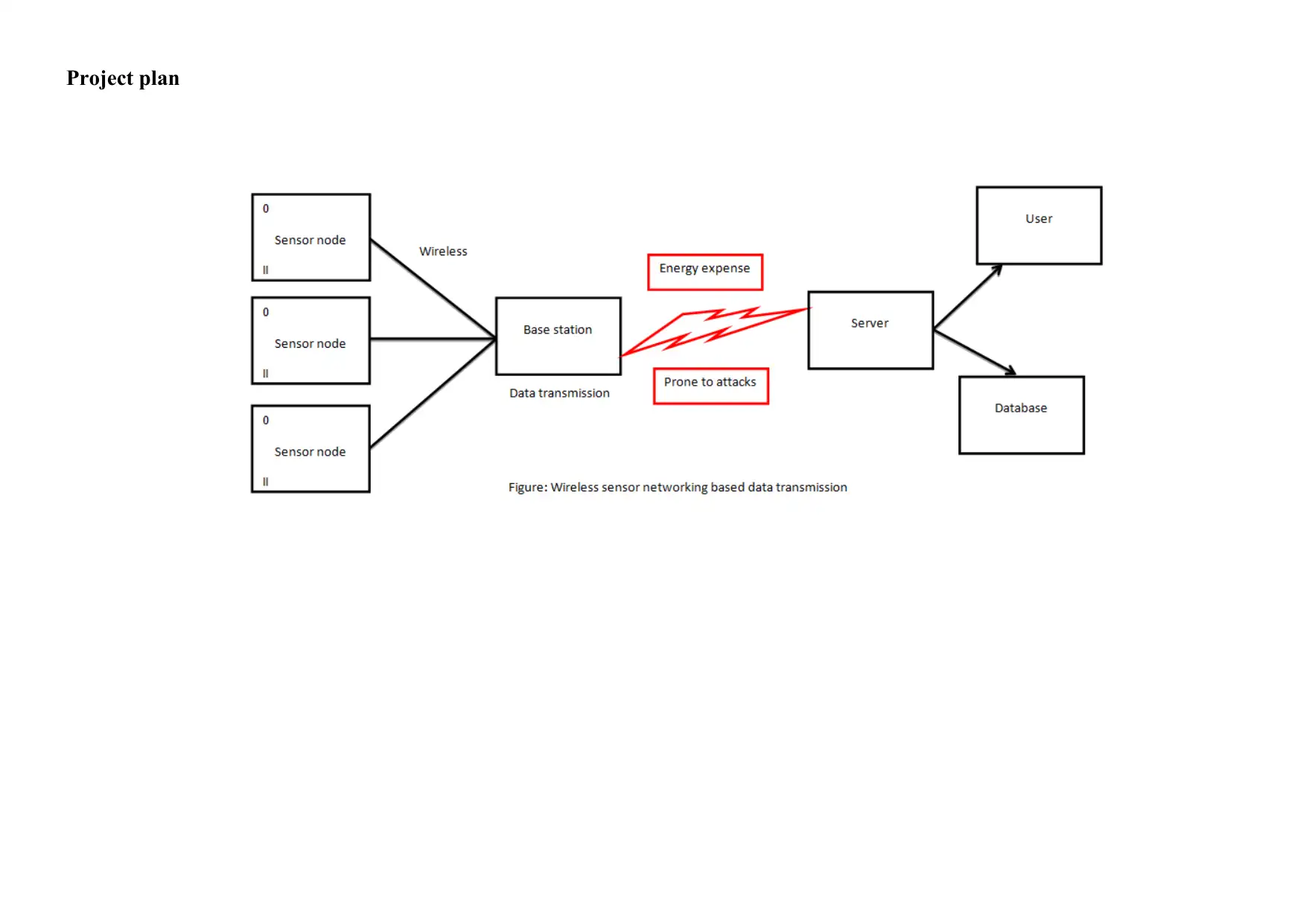ITC571 Project: Pulse Code Modulation for WSN Energy Efficiency
VerifiedAdded on 2024/06/28
|5
|939
|415
Project
AI Summary
This project proposal investigates the use of Pulse Code Modulation (PCM) to optimize data transmission and enhance energy efficiency in Wireless Sensor Networks (WSNs). The proposal identifies the energy consumption challenges in WSNs due to data aggregation and transmission, particularly with existing techniques that may compromise data security. The research aims to improve energy efficiency, maintain data trustworthiness, and address security risks by implementing PCM-based data aggregation. The methodology involves identifying existing issues, conducting a literature review to evaluate current solutions, and proposing an improved solution based on PCM. Expected outcomes include enhanced energy efficiency, improved security, and reliable data delivery in WSNs.

Writing Proposal Template for ITC571
Student Name and ID
Project area
Networking
Type of Project
Practical/Theoretical/Review
Technology
Pulse code Modulation
Technique
Optimise Data Transmission
Domain
Energy efficiency in wireless networks
Project name
Pulse code modulation uses data transmission optimisation for energy efficiency in wireless networks
Key words
Wireless sensor networks, energy efficient wireless networking, data transmission
1. Introduction
Background Information, Issues and Current Solutions
1. When wireless sensors networks are engaged with optimise data transmission, considering both base station and cluster head engagement, aggregation of
data is required. Every router attached is in need to perform data aggregation. However, due to energy inefficient node employment for this action, the life-
time of sensor network is reduced. Data Transmission Optimisation techniques like computer simulation or computer devices are currently in practice
existing at both cluster and base ends. The domain of this proposal is to visualise the impacts on the Wireless sensor networks.
Shortcomings/ limitations in the current /existing solutions
2. It is required that the data aggregation and optimise data transmission techniques adopted within wireless sensor networking is applied in optimum
manner. As the deployment of sensors is dispersed to diverse locations, there are alerted chances of being compromised by attacks such as false data
injection, false decision making etc. even with the optimise data transmission techniques like computer simulation or computer devices to aid the energy
expenses. These attempts reduce the trustworthiness of the processed and optimise transmitted data.
Importance of solving this problem
3. As the energy efficient adoptions are made the optimise data transmission side of various exposed nodes increases. This is turn is more harmful than the
energy expense itself. With no implication of aggregator, the accuracy of processed data will be compromised which cannot be any option. Thus this
research is in projection to improvise this optimise data transmission or aggregation stage for improvisation in energy consumption. Pulse code Modulation
technology is being used in this.
Student Name and ID
Project area
Networking
Type of Project
Practical/Theoretical/Review
Technology
Pulse code Modulation
Technique
Optimise Data Transmission
Domain
Energy efficiency in wireless networks
Project name
Pulse code modulation uses data transmission optimisation for energy efficiency in wireless networks
Key words
Wireless sensor networks, energy efficient wireless networking, data transmission
1. Introduction
Background Information, Issues and Current Solutions
1. When wireless sensors networks are engaged with optimise data transmission, considering both base station and cluster head engagement, aggregation of
data is required. Every router attached is in need to perform data aggregation. However, due to energy inefficient node employment for this action, the life-
time of sensor network is reduced. Data Transmission Optimisation techniques like computer simulation or computer devices are currently in practice
existing at both cluster and base ends. The domain of this proposal is to visualise the impacts on the Wireless sensor networks.
Shortcomings/ limitations in the current /existing solutions
2. It is required that the data aggregation and optimise data transmission techniques adopted within wireless sensor networking is applied in optimum
manner. As the deployment of sensors is dispersed to diverse locations, there are alerted chances of being compromised by attacks such as false data
injection, false decision making etc. even with the optimise data transmission techniques like computer simulation or computer devices to aid the energy
expenses. These attempts reduce the trustworthiness of the processed and optimise transmitted data.
Importance of solving this problem
3. As the energy efficient adoptions are made the optimise data transmission side of various exposed nodes increases. This is turn is more harmful than the
energy expense itself. With no implication of aggregator, the accuracy of processed data will be compromised which cannot be any option. Thus this
research is in projection to improvise this optimise data transmission or aggregation stage for improvisation in energy consumption. Pulse code Modulation
technology is being used in this.
Paraphrase This Document
Need a fresh take? Get an instant paraphrase of this document with our AI Paraphraser

2. The Main objective and purpose of this research
1. Purposes and aims of this research work are:
To increase the energy efficiency of data transmission optimisation process adopted within wireless sensor network operations.
To ensure the energy saving level of the transmitted data which is optimised via WSN
To maintain the trustworthiness of WSN processing with implication of Pulse code Modulation.
3. Questions need to be answered
The questions need to be created based on the objective that you set. These question will be used to collect accurate information in your literature review
stage
Q1 How optimized data is transmitted in wireless sensor networks?
Q2 How the systems can be made energy efficient and optimize the results?
Q3 What new models can be adopted to increase the efficiency of the existing models?
Q4 What are the drawbacks of currently used models?
Q5 What are the existing methods that transmit optimized data over wireless sensor networks?
4. A Brief Description of Your Proposal
When it comes to wireless sensor networking, energy expense has become a primary issue. It is very obvious that sensor networks are completely powered
by battery this limits their working life. Implementation of Pulse code Modulation is the technology that makes the optimise data transmission in an energy
efficient way more complex and challenging. Implementation of Pulse code Modulation based optimised data aggregation can tentatively address this issue.
The processing methodology projects to increase the networking lifetime.
5. The Process or Methodology of Your Project
1. Issues based on optimised data transmission
Identification of the existing wireless sensor based processing
Evaluation of the issues faced in optimised data transmission, that is energy inefficiency
1. Purposes and aims of this research work are:
To increase the energy efficiency of data transmission optimisation process adopted within wireless sensor network operations.
To ensure the energy saving level of the transmitted data which is optimised via WSN
To maintain the trustworthiness of WSN processing with implication of Pulse code Modulation.
3. Questions need to be answered
The questions need to be created based on the objective that you set. These question will be used to collect accurate information in your literature review
stage
Q1 How optimized data is transmitted in wireless sensor networks?
Q2 How the systems can be made energy efficient and optimize the results?
Q3 What new models can be adopted to increase the efficiency of the existing models?
Q4 What are the drawbacks of currently used models?
Q5 What are the existing methods that transmit optimized data over wireless sensor networks?
4. A Brief Description of Your Proposal
When it comes to wireless sensor networking, energy expense has become a primary issue. It is very obvious that sensor networks are completely powered
by battery this limits their working life. Implementation of Pulse code Modulation is the technology that makes the optimise data transmission in an energy
efficient way more complex and challenging. Implementation of Pulse code Modulation based optimised data aggregation can tentatively address this issue.
The processing methodology projects to increase the networking lifetime.
5. The Process or Methodology of Your Project
1. Issues based on optimised data transmission
Identification of the existing wireless sensor based processing
Evaluation of the issues faced in optimised data transmission, that is energy inefficiency

Narrowing the problem to explore the existing solutions addressing this issue
2. Literature review (LR)
Evaluation of established solution through legitimate sources from CSU library
Data analysis and comparative evaluation
Determination of the best possible solution to address the identified issue
3. Propose a better solution
Analysis of the processing of the current best solution
Realization of its strengths and weaknesses
Proposal of a solution to overcome the shortcomings of current best solution
Implication justification
5. Expected Outcomes
The research work has several expected outcomes:
Enhancing the energy efficiently in optimised data transmission or aggregation process
Improving the security risks in nodal exposure of network
Providing genuine and trustful data to the end user from the provider end.
Reference list
Bibliography
Kaur, S., & Mahajan, R. (2018). Hybrid meta-heuristic optimization based energy efficient protocol for wireless sensor networks. Egyptian Informatics
Journal. Retrieved from https://www-sciencedirect-com.ezproxy.csu.edu.au/science/article/pii/S1110866517300658
Kiani, F. (2018). Animal behavior management by energy-efficient wireless sensor networks. Computers and Electronics in Agriculture, 478-484. Retrieved
from https://www-sciencedirect-com.ezproxy.csu.edu.au/science/article/pii/S0168169917307299
Mohamed, R., Ghanem, W., Khalil, A., Elhoseny, M., Sajjad, M., & Mohamed, M. (2018). Energy Efficient Collaborative Proactive Routing Protocol for
Wireless Sensor Network. Computer Networks. Retrieved from https://www-sciencedirect-com.ezproxy.csu.edu.au/science/article/pii/
S1389128618303748
2. Literature review (LR)
Evaluation of established solution through legitimate sources from CSU library
Data analysis and comparative evaluation
Determination of the best possible solution to address the identified issue
3. Propose a better solution
Analysis of the processing of the current best solution
Realization of its strengths and weaknesses
Proposal of a solution to overcome the shortcomings of current best solution
Implication justification
5. Expected Outcomes
The research work has several expected outcomes:
Enhancing the energy efficiently in optimised data transmission or aggregation process
Improving the security risks in nodal exposure of network
Providing genuine and trustful data to the end user from the provider end.
Reference list
Bibliography
Kaur, S., & Mahajan, R. (2018). Hybrid meta-heuristic optimization based energy efficient protocol for wireless sensor networks. Egyptian Informatics
Journal. Retrieved from https://www-sciencedirect-com.ezproxy.csu.edu.au/science/article/pii/S1110866517300658
Kiani, F. (2018). Animal behavior management by energy-efficient wireless sensor networks. Computers and Electronics in Agriculture, 478-484. Retrieved
from https://www-sciencedirect-com.ezproxy.csu.edu.au/science/article/pii/S0168169917307299
Mohamed, R., Ghanem, W., Khalil, A., Elhoseny, M., Sajjad, M., & Mohamed, M. (2018). Energy Efficient Collaborative Proactive Routing Protocol for
Wireless Sensor Network. Computer Networks. Retrieved from https://www-sciencedirect-com.ezproxy.csu.edu.au/science/article/pii/
S1389128618303748
⊘ This is a preview!⊘
Do you want full access?
Subscribe today to unlock all pages.

Trusted by 1+ million students worldwide

Tsoumanis, G., Oikonomou, K., Koufoudakis, G., & Aïssa, S. (2018). Energy-efficient Sink Placement in Wireless Sensor Networks. Computer Networks.
Retrieved from https://www-sciencedirect-com.ezproxy.csu.edu.au/science/article/pii/S1389128618303244
Retrieved from https://www-sciencedirect-com.ezproxy.csu.edu.au/science/article/pii/S1389128618303244
Paraphrase This Document
Need a fresh take? Get an instant paraphrase of this document with our AI Paraphraser

Project plan
1 out of 5
Related Documents
Your All-in-One AI-Powered Toolkit for Academic Success.
+13062052269
info@desklib.com
Available 24*7 on WhatsApp / Email
![[object Object]](/_next/static/media/star-bottom.7253800d.svg)
Unlock your academic potential
Copyright © 2020–2025 A2Z Services. All Rights Reserved. Developed and managed by ZUCOL.





